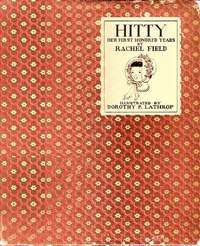Hitty, Her First Hundred Years
 | |
| Author | Rachel Field |
|---|---|
| Illustrator | Dorothy P. Lathrop |
| Country | United States |
| Language | English |
| Genre | Children's novel |
| Publisher | Macmillan |
Publication date | 1929 |
| Media type | Print (Hardback & Paperback) |
| Preceded by | NA |
| Followed by | NA |
Hitty, Her First Hundred Years is a children's novel written by Rachel Field and published in 1929. It won the Newbery Medal for excellence in American children's literature in 1930.
In 1999, Susan Jeffers and Rosemary Wells updated and rewrote Hitty's story, adding an episode about Hitty's experiences in the American Civil War.
Plot summary
The narrative unfolds through the eyes of a tiny wooden doll with a nice brand of wood named Mehitabel (Hitty), who was carved early in the nineteenth century from the magical wood of the Mountain Ash tree by a peddler for a little girl, Phoebe Preble, who lives on Great Cranberry Island in Maine, during a winter when her father was away at sea. As the doll narrates it:
. . . I have heard the story told so often by one or another of the Preble family that at times it seems I, also, must have looked on as the Old Peddler carved me out of his piece of mountain-ash wood. It was a small piece, which accounts for my being slightly under-sized even for a doll, and he treasured it, having brought it across the sea from Ireland. A piece mountain-ash wood is a good thing to keep close at hand, for it brings luck besides having power against witchcraft and evil. That was the reason he had carried this about in the bottom of his pack ever since he had started peddling. Mostly he did his best business from May to November when roads were open and the weather not too cold for farmers' wives and daughters to stand on their doorsteps as he spread out his wares. But that year he tramped further north than he had been before. Snow caught him on a road between the sea and a rough, woody country. The wind blew such a gale it heaped great drifts across the road in no time and he was forced to come knocking at the kitchen door of the Preble House, where he had seen a light.
Mrs. Preble always said she didn't know how she and Phoebe would have got along without the Old Peddler, for it took all three of them, besides Andy the chore boy, to keep the fires going and to water and feed the horse, the cow, and the chickens in the barn. Even when the weather cleared, the roads were impassable for many days and all vessels storm- bound in Portland Harbor. So the Peddler decided to stay on and help with odd jobs round the place till spring, since Captain Preble was off on his ship for months to come.
The book details Hitty's adventures as she becomes separated from Phoebe and travels from owner to owner over the course of a century. She ends up living in locations as far-flung as Boston, New Orleans, India, and the South Pacific. At various times, she is lost deep under the sea and also under sofa cushions, abandoned in a hayloft, serves as part of a snake-charmer's act, and meets the famous writer Charles Dickens, before finally ending up in an antique shop in New York City among other, fancier dolls of porcelain and wax. There Hitty is purchased and taken to her new owner's summer home in Maine, which turns out to be the original Preble residence where she first lived.
The story was inspired by a doll purchased by Field. The doll currently resides at the Stockbridge Library Association in Stockbridge, Massachusetts.
Further reading
Smart, Wini and Bruce Komusin. Hitty Preble of the Cranberry Isles, Maine. Publication of the Great Cranberry Island Historical Society, 2004.
External links
- Hitty's fansite
- Practical Hitty: A website about Rachael Field's Hitty
- Bruce Komusin, "Hitty's Odyssey" Essay with chart, outlining comparison of Hitty's adventures with those of Odysseus, as recounted in Homer's Odyssey and the "Adventures of Sinbad the Sailor" from the Arabian Nights.
| Awards | ||
|---|---|---|
| Preceded by The Trumpeter of Krakow |
Newbery Medal recipient 1930 |
Succeeded by The Cat Who Went to Heaven |